
Bubble and squeak is a British dish made from cooked potatoes and cabbage, mixed together and fried. The food writer Howard Hillman classes it as one of the "great peasant dishes of the world". The dish has been known since at least the 18th century, and in its early versions it contained cooked beef; by the mid-20th century the two vegetables had become the principal ingredients.

Polish cuisine is a style of cooking and food preparation originating in or widely popular in Poland. Due to Poland's history, Polish cuisine has evolved over the centuries to be very eclectic, and it shares many similarities with other regional cuisines. Polish-styled cooking in other cultures is often referred to as à la polonaise.

Fried rice is a dish of cooked rice that has been stir-fried in a wok or a frying pan and is usually mixed with other ingredients such as eggs, vegetables, seafood, or meat. It is often eaten by itself or as an accompaniment to another dish. Fried rice is a popular component of East Asian, Southeast Asian and certain South Asian cuisines, as well as a staple national dish of Indonesia. As a homemade dish, fried rice is typically made with ingredients left over from other dishes, leading to countless variations. Fried rice first developed during the Sui Dynasty in China.

Yakisoba, "fried noodle", is a Japanese noodle stir-fried dish. Usually, soba noodles are made from buckwheat flour, but soba in yakisoba are Chinese noodles made from wheat flour, typically flavored with a condiment similar to Worcestershire sauce. The dish first appeared in food stalls in Japan around the 1930s.
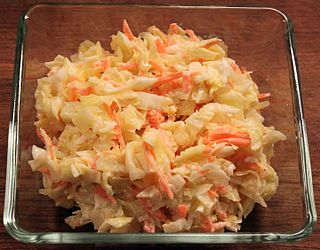
Coleslaw, also known as cole slaw, or simply as slaw, is a side dish consisting primarily of finely shredded raw cabbage with a salad dressing or condiment, commonly either vinaigrette or mayonnaise. This dish originated in the Netherlands in the 18th century. Coleslaw prepared with vinaigrette may benefit from the long lifespan granted by pickling.
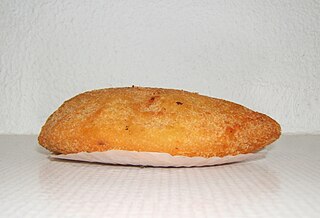
A rissole is a small patty created in France, enclosed in pastry, or rolled in breadcrumbs, usually baked or deep fried. The filling has savory ingredients, most often minced meat, fish or cheese, and is served as an entrée, main course, or side dish.

Tamil cuisine is a culinary style originating in the southern Indian state of Tamil Nadu and other countries of South Asia like Sri Lanka. Meats, along with rice, legumes, and lentils, are also popular. Dairy products and tamarind are used to provide sour flavors. On special occasions, traditional Tamil dishes are served in a traditional manner, using banana leaves in place of utensils. After eating, the banana leaves are then used as a secondary food for cattle. A typical breakfast meal consists of idli or dosa with chutney. Lunch includes rice, sambar, curd, kuzhambu, and rasam.

Chai tow kway is a common dish or dim sum of Teochew cuisine in Chaoshan, China. It is also popular in Indonesia, Singapore, Malaysia, Thailand, Taiwan and Vietnam, consisting of stir-fried cubes of radish cake. In some places such as Singapore, it is confusingly and mistakenly translated as carrot cake.

Escabeche is the name for a number of dishes in Spanish, Portuguese, Filipino and Latin American cuisines, consisting of marinated fish, meat or vegetables, cooked or pickled in an acidic sauce, and colored with paprika, citrus, and other spices.

The carrot is a root vegetable, typically orange in color, though purple, black, red, white, and yellow cultivars exist, all of which are domesticated forms of the wild carrot, Daucus carota, native to Europe and Southwestern Asia. The plant probably originated in Persia and was originally cultivated for its leaves and seeds. The most commonly eaten part of the plant is the taproot, although the stems and leaves are also eaten. The domestic carrot has been selectively bred for its enlarged, more palatable, less woody-textured taproot.
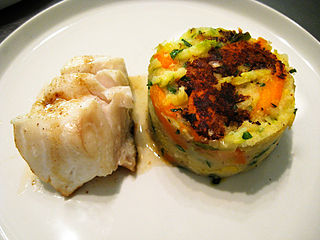
Stoemp is a Belgian dish of pureed or mashed potatoes and other root vegetables, and can also include cream, bacon, onion or shallot, herbs, and spices.
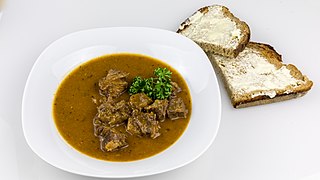
Oxtail soup is a soup made with beef tails. The use of the word "ox" in this context is a legacy of nomenclature; no specialized stock of beef animals are used and tails may come from bovines other than oxen. It is believed by some that oxtail soup was invented in Spitalfields in London in the seventeenth century by French Huguenot and Flemish immigrants, from the tails of animals.[more citations needed] Different versions of oxtail soup exist: Korean; Chinese; a fried/barbecued oxtail combined with soup variation which is a popular dish in Indonesia where it is called as sop buntut; an ethnic dish of the American South which traces its lineage back to the pre-revolutionary war era; and a thick, rich, gravy-like soup popular in the United Kingdom since the 18th century. Creole oxtail soup is made from a tomato base with oxtails, potatoes, green beans, corn, mirepoix, garlic, and herbs and spices.

Turnip cake is a Chinese dim sum dish. The less commonly used radish cake is a more accurate name, as Western-style turnips are not used in the dish but rather shredded radish and plain rice flour. It is traditionally called carrot cake in Singapore.
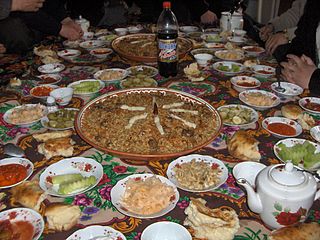
Tajik cuisine is a traditional cuisine of Tajikistan, and has much in common with Russian, Afghan, Iranian and Uzbek cuisines. Plov (pilaf), also called osh, is the national dish in Tajikistan, as in other countries in the region. Green tea is the national drink.

Cap cai, sometimes spelled cap cay, is the Hokkien-derived term for a popular Chinese Indonesian and Peranakan stir-fried vegetable dish that originates from Fujian cuisine.

Carrot chips are carrots that have been fried or dehydrated. Some carrot manufacturers also refer to bagged, sliced carrots as carrot chips. The fried version of carrot chips is often referred to as carrot fries, especially when the chips are made in the shape of french fries. Fried carrot chips have an oil content of 35-40%.

Lumpia are various types of spring rolls commonly found in Indonesia and the Philippines. Lumpia are made of thin paper-like or crepe-like pastry skin called "lumpia wrapper" enveloping savory or sweet fillings. It is often served as an appetizer or snack, and might be served deep-fried or fresh (unfried). Lumpia are Indonesian and Filipino adaptations of the Fujianese rùnbǐng and Teochew popiah, usually consumed during Qingming Festival.

Spring rolls are rolled appetizers or dim sum commonly found in Chinese and Southeast Asian cuisines. The kind of wrapper, fillings, and cooking technique used, as well as the name, vary considerably depending on the region's culture, though they are generally filled with vegetables.

Bagoong fried rice, also known as binagoongan fried rice or anglicized as shrimp paste fried rice, is a Filipino fried rice dish cooked by stir-frying pre-cooked rice with sauteed bagoong alamang, toasted garlic, spring onions, shallots, julienned sour green mangoes, and optionally other ingredients like chilis, cucumbers, jicamas, carrots, scrambled eggs, chicharon, and tomatoes. It is usually light pink in color due to the use of angkak coloring agent from the bagoong. It is eaten paired with meat and seafood dishes, or is cooked with chunks of meat and seafood and eaten as is.


















